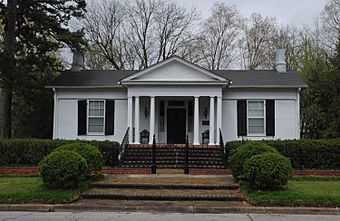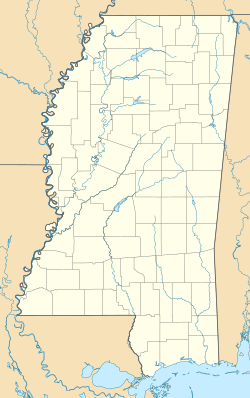Dunvegan (Holly Springs, Mississippi) facts for kids
Quick facts for kids |
|
|
Dunvegan
|
|
|
U.S. Historic district
Contributing property |
|

Dunvegan in 2008.
|
|
| Location | 159 Gholson Avenue West, Holly Springs, Mississippi, U.S. |
|---|---|
| Built | 1845 |
| Architectural style | Greek Revival |
| Part of | Southwest Holly Springs Historic District (ID83000963) |
| Added to NRHP | April 20, 1983 |
Dunvegan, also known as the Norfleet-Cochran House, is a special historic home in Holly Springs, Mississippi, USA. It was built in 1845. This house is known for its unique "English Basement" style. This means the kitchen and dining room are downstairs, while the bedrooms and living rooms are on the upper floor.
The house was first built for Jesse P. Norfleet. He was a cabinetmaker from Virginia who married into a wealthy family. Later, he became a successful farmer and business owner. In the 1970s, the house was given the name Dunvegan. This name comes from a town called Dunvegan on the Scottish island of Skye.
Contents
Where is Dunvegan Located?
Dunvegan is found at 154 West Gholson Avenue in Holly Springs, Mississippi. It is a notable landmark in the area.
The Story of Dunvegan House
Building a Unique Home in 1845
The land for Dunvegan was bought by Jesse P. Norfleet on January 3, 1845. The house itself was built later that same year. It was designed in the Greek Revival style. This style was very popular back then, with its grand columns and classic look.
The builders used strong pine wood for the roof supports. The bricks for the house were all made by hand. As an "English Basement" cottage, its design was quite different from many American homes. The main living areas were upstairs, and the kitchen was in the basement.
The Norfleet Family and Early Owners
Jesse P. Norfleet came from Suffolk, Virginia. He married Jane H. Carlock, whose father, Moses Carlock, was a rich farmer. Jesse Norfleet's granddaughter, Ada, married Henry Oscar Rand. Their son, Frank C. Rand, later became the head of the International Shoe Company.
On September 28, 1861, Jesse Norfleet traded houses with James Jarrell House. Later, in 1886, T. F. Sigman bought Dunvegan. He owned the house for more than 30 years, until 1920. During his time, the front porch of the house was changed several times.
The Cochran Family and Renaming Dunvegan
In 1920, the house was sold to Samuel Vadah Cochran, Sr. and his wife Rita Binion Cochran. Rita Binion Cochran decided to rebuild the front porch. She wanted it to look like the porch of a nearby house called Featherstone Place. An architect named Theodore Link had recently worked on that house. The porch she designed is still there today.
After Samuel Cochran Sr. passed away in 1971, his son, Samuel Vadah Cochran, Jr., inherited the house. Samuel Vadah Cochran, Jr. was a Professor of English at Memphis State University in Tennessee. He was also a talented painter. His artwork was shown in galleries, and he even painted murals inside Dunvegan. He also designed the beautiful gardens around the house.
Samuel Vadah Cochran, Jr. and his wife Doris Sigman Cochran gave the house its current name, Dunvegan. They chose this name because his ancestors, the McLeod family, came from the town of Dunvegan on the Scottish island of Skye. The Cochrans would open their home to the public for tours once a year.
Why Dunvegan is Important
Dunvegan is a very important historical building. It is part of the Southwest Holly Springs Historic District. Because of its historical value, it has been listed on the National Register of Historic Places since April 20, 1983. This means it is recognized as a significant part of American history and architecture.



